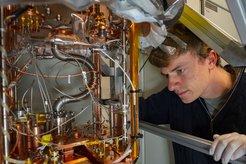Erbium atoms in silicon: A prime candidate for quantum networks
A team of researchers at the Max Planck Institute of Quantum Optics has laid the foundation for the development of future quantum networks. The scientists embedded individual erbium atoms in crystalline silicon, creating ideal conditions for storing and passing on quantum information.
A team of researchers at the MPQ has pioneered the integration of erbium atoms with special optical properties into a silicon crystal. The atoms can thus be connected by light at a wavelength that is commonly used in telecommunications. This makes them ideal building blocks for future quantum networks that enable calculations with several quantum computers, as well as the secure exchange of data in a quantum internet. Since the new experimental results were achieved without sophisticated cooling and are based on established methods of semiconductor production, the method appears suitable for large networks.

When quantum computers are connected to a network, completely new possibilities arise – analogous to the internet consisting of interconnected classical computers. Such a quantum network can be realised by entangling individual carriers of quantum information, so-called qubits, with each other using light. The qubits, in turn, can be built from individual atoms that are isolated from one another and embedded in a host crystal. A team of researchers at the Max Planck Institute of Quantum Optics (MPQ) in Garching and the Technical University of Munich has now demonstrated a feasible way to build a quantum network using atoms in a silicon crystal. This means that the same technology employed in classical computers can also be used for quantum computers and their networks.
Low losses and strong coherence
The new technology relies on erbium atoms that are implanted into the crystal lattice of silicon under very specific conditions. "We knew from earlier experiments that erbium has good optical properties for such an application," says Dr Andreas Reiserer, head of the Otto Hahn Quantum Networks research group at MPQ: The atoms of this rare-earth element emit infrared light at a wavelength of around 1550 nanometres – the spectral range used for data transport in optical fibre cables. It exhibits only low loss during propagation in a light-conducting fiber. "In addition, the light emitted by erbium has excellent coherence," Reiserer notes. This means that individual wave trains are in a stable phase relationship to one another – a prerequisite for the storage and transmission of quantum information. "These characteristics make erbium a prime candidate for realising a quantum computer – or for being used as an information carrier in a quantum network," Reiserer emphasises.
However, what may sound simple, posed a tricky technological challenge for the MPQ researchers. Among other things, the team had to embed individual atoms of the rare-earth element in the crystalline matrix in a targeted and reproducible manner – and fix them in specific positions relative to the silicon atoms. "We chose silicon for this because it is already used for classical semiconductors that form the basis of our information society," explains the physicist. "Established processes are available for the preparation of silicon crystals of high quality and purity."
Moderate temperatures, narrow spectral lines

To integrate erbium atoms into such a crystal – in technical jargon: to dope it – it first had to be endowed with nanometre-fine structures. They serve as light-conducting elements. Then, the researchers irradiated the silicon with a beam of erbium ions so that individual atoms penetrated and dispersed to different places at high temperatures. "In contrast to the usual procedure, we did not heat the chips to 1000, but only to a maximum of 500 degrees Celsius," says Andreas Gritsch, a doctoral student in the team. The consequence of the comparatively moderate temperature was a particularly stable integration of individual erbium atoms in the crystal lattice, without a larger number of atoms clustering together. "This manifested itself in unusually narrow spectral lines in the emission of infrared light by the erbium," reports Gritsch: at around 10 kilohertz, which is the smallest spectral linewidth measured in nanostructures to date. "This is also a favourable property for the construction of a quantum network," the researcher emphasises.
And there is another feature that distinguishes the method optimised by the Garching researchers for doping the silicon crystal: The excellent optical properties of the introduced erbium atoms do not only show up in the immediate vicinity of absolute zero at minus 273 degrees Celsius as in previous experiments. Instead, they can also be observed at temperatures considered “high" for quantum phenomena of around 8 Kelvin (degrees above absolute zero). "Such a temperature can be achieved by cooling in a cryostat with liquid helium," says Andreas Reiserer. "This is technologically easy to realise and paves the way towards future applications."
Diverse potential applications
The range of possible future applications for quantum networks is broad, as the Max Planck researcher explains: Quantum computers could be built from them, in which a large number of separate processors are interconnected. With such computing machines, which use certain quantum mechanical effects, complex tasks can be mastered that cannot be solved with conventional, classical systems. Alternatively, quantum networks could be used to investigate the properties of new types of materials. "Or they could be used to build a kind of quantum internet in which previously unattainable amounts of information could be transmitted – similar to the normal internet, but encrypted securely using quantum cryptography," says Reiserer.
The prerequisite for all these potential applications is to quantum-mechanically entangle qubits in a network. "To show that this is also possible based on erbium atoms in silicon chips is our next task," says Andreas Reiserer. Together with his team, the physicist is already working on mastering this challenge. His goal: To show that the circuits for powerful quantum networks can be produced similarly to microchips for mobile phones or notebook computers – but pave a broad field for new scientific findings and technical possibilities that are unthinkable today.













